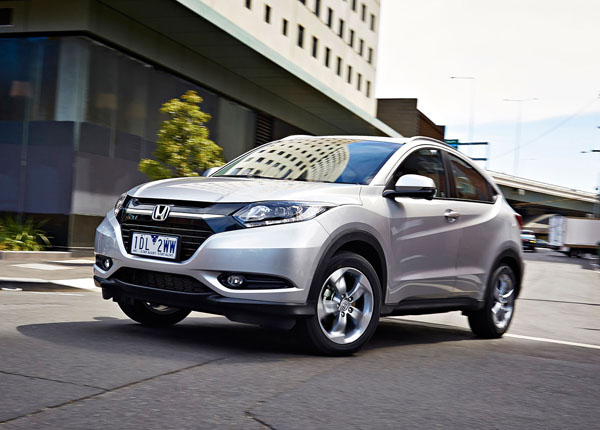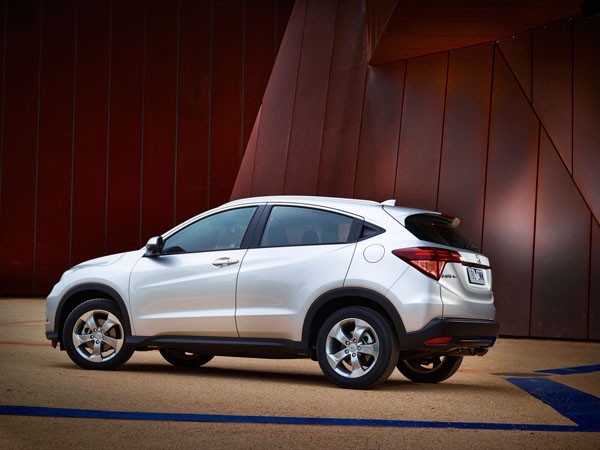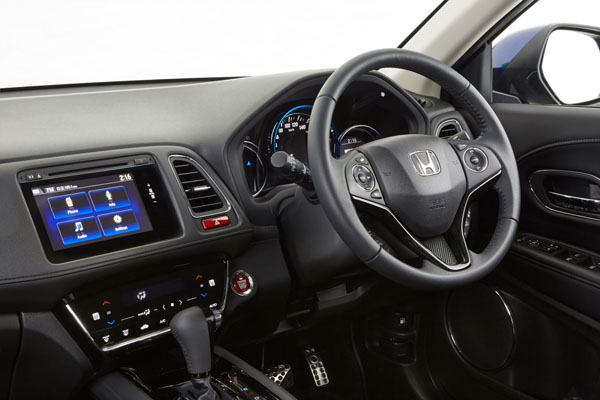The CR-V has always been the king of the castle in Honda SUV-land ahead of the HR-V and MDX, although CR-V wasn’t the first such Honda to appear. That was left to the HR-V way back in 1999.
The small sports utility vehicle was considered ahead of its time, mainly because it was one of the first to gain a Low Emission Vehicle exhaust emission standard. It achieved an amazing 80 per cent fewer emissions than Australian regulations of the day required.
As they say, you can’t keep a good dog down and the pup recently made a return to the Honda SUV stable in a much different guise to the original. There’s also a little bit of magic on offer, with Honda’s innovative Magic Seat system, which can be configured in 18 different ways, making for versatile cargo carrying capability.
The new HR-V comes in four variants – VTi, VTi-S, VTi-L and VTi-L ADAS – going to market from $24,990 to $33,990, plus on-road costs.
Honda’s ADAS is a system of advanced active safety features including Forward Collision Warning, Lane Departure Warning and High-Beam Support.
STYLING
Gone is the square, upright stance of last century. In its place is a compact SUV very much of today. Edgy lines brought together in a sleek silhouette, with the latest lighting technology including LED headlamps and the ubiquitous daytime running lights setting the ball rolling up front.
Although leaning towards a coupe in its exterior styling, a fact emphasised by sharply raked windscreen, bold grille and flared wheel arches plus concealed handles positioned in the door edge close to a quarter light to produce a two-door effect, there is no lack of interior space.
A clearly arranged instrument layout is designed to involve the driver and front-seat passenger. Occupants are put at ease in seats clothed in soft-weave European fabric – in the VTi-L test vehicle we borrowed, quality leather – with bases lengthened to those of most luxury sedans.
INFOTAINMENT
Honda HR-V offers advanced audio, information and connectivity features such as 7-inch touch screen; Bluetooth connectivity for Apple and Android systems, including audio streaming; Siri, compatible with iPhone; and HDMI audio and video playback.
ENGINE / TRANSMISSION
The front-wheel-drive HR-V is powered by a 1.8-litre four-cylinder single (yes, single) overhead cam engine mated with Honda’s continuously variable automatic transmission.
The engine puts out 105 kilowatts of power at 6500 rpm and 172 Newton metres of torque at 4300 revs, while using, the maker claims, between 6.6 and 6.9 litres of fuel per 100 kilometres, depending on the model, on the combined urban / highway cycle. Carbon dioxide emissions of between 155 and 160 g per kilometre are stated.
The test VTi-L recorded 6.1 litres per 100 kilometres on the motorway and was entrenched in the upper eights in town tripping. So it was pretty close to the claimed numbers, not something you see in all cars these days.
SAFETY
As well as the normal suite of passive and active safety systems, the top-of-the-range VTi-L ADAS incorporates a new range of safety technology – Honda’s Advanced Driver Assist System – designed to complement the driver’s input.
Forward Collision Warning, above 15 kilometres per hour, warns of a slowing vehicle ahead with a visible and audible signal in the multifunction display.
Lane Departure Warning determines if the vehicle is unintentionally leaving the lane in which it is travelling by identifying the lane markings in reference to the vehicle. Visible and audible warning is given.
High-Beam Support uses a camera to monitor the space ahead of the vehicle and automatically changes the low beam headlights to high beam when necessary.
DRIVING
There’s feedback to the driver via an illuminated speedometer ring which changes colour to match how economically the car is being driven.
The HR-V is the first Honda vehicle to be equipped with an electric parking brake, replacing the more common hand or foot brake. Operated via a switch in the centre console, it reduces driver effort and worry about applying enough force to the brake lever to hold the vehicle.
It’s automatically released on setting off with the driver seatbelt engaged. Pressing an adjacent ‘brake hold’ button keeps the brake on once the vehicle is stationary, a boon in stop/start traffic.
Rear legroom is impressive, even with the front seats in their most rearward position. The front passenger is pampered with a wide climate control vent divided into three zones. The airflow for the outboard zone, which is most vulnerable to radiant heat from outside the vehicle, is set high to allow for this. The middle is set to low, while the inner vent is on medium.
The CVT, shared with the Odyssey, City and Jazz, is designed to enhance driving performance and fuel economy. The VTi-L model has the benefit of steering wheel-mounted paddle shifts offering a manual shifting feel. D mode is fully automatic and produces stressless driving in a wide range of conditions.
For more involvement, the driver can engage S mode, which includes seven ratios. The system only shifts automatically to prevent over-revving or overworking the engine, the rest is up to the driver.
SUMMING UP
Honda says its aim is to make sure the HR-V can hold its own with the company’s other global core models, Civic, Accord and CR-V. The HR-V’s focus on state-of-the-art technology, contemporary styling and dynamic performance should go a long way to making sure this happens.
AT A GLANCE
Honda HR-V VTi: $24,990 (CVT automatic)
Honda HR-V VTi-S: $27,990 (CVT automatic)
Honda HR-V VTi-L: $32,990 (CVT automatic)
Honda HR-V VTi-L ADAS: $33,990 (CVT automatic)
Note: These prices do not include dealer or government charges. Contact your local Honda dealer for drive-away prices.
STANDARD FEATURES
16in alloy wheels
LED rear combination tail lights
Honda’s unique Magic Seats
Halogen headlights with Daytime Running Lights (bulb type)
Display Audio system with Bluetooth connectivity (Android and Apple) and 7in colour touch screen
Single zone climate control air-conditioning
Multi-angle reversing camera with three model
17in alloy sports wheels (VTi-L)
Paddle shifters (VTi-L)
Leather-appointed seat trim (VTi-L)
Panoramic sunroof (VTi-L)
Front and rear parking sensors (VTi-L)
Privacy glass (VTi-L)
Dual-zone climate control (VTi-L)
Chrome door handles (VTi-L)
SPECIFICATIONS:
ENGINE (1.8-litre i-VTEC 4cyl petrol engine)
Capacity: 1799 cc
Configuration: In-line 4-cylinder
Bore and stroke: 73 mm x 89.4 mm
Compression ratio: 10.6:1
Maximum Power: 105 kW @ 6500 rpm
Maximum Torque: 172 Nm @ 4300 rpm
Emissions: Euro 5
DRIVELINE:
Drivetrain: Continuously variable transmission, front-wheel drive
DIMENSIONS, WEIGHT AND CAPACITIES:
Length: 4294 mm
Width: 1772 mm
Height: 1605 mm
Wheelbase: 2610 mm
Track: 1535 mm (front), 1540 mm (rear)
Ground clearance: 170 mm
Tare mass: 1366 kg
Seating capacity: 5
Cargo capacity 375 litres
Fuel Tank Capacity: 50 litres
Turning circle: 10.6 m
SUSPENSION AND BRAKES:
Suspension: MacPherson strut (front); torsion beam (rear)
Brakes: Ventilated discs (front); solid discs (rear). ABS anti-skid brake system with Electronic Brake-force Distribution, Vehicle Stability Control. Traction Control. Electric parking brake. Hill Start Assist
Steering: Electric power assisted rack and pinion
Wheels / tyres: Alloy 17 x 7J (sports wheel design) / 215/55 R17 94V. Space saver spare
PERFORMANCE
Acceleration 0 to 100 km/h: N/A
Top speed: N/A
FUEL CONSUMPTION:
Fuel type: 91 RON unleaded
Combined Cycle (ADR 81/01): 6.9 litres per 100 km. CO2 emissions 160 g / km
GREEN VEHICLE GUIDE RATINGS:
Greenhouse Rating: 7.5 / 10
Air Pollution Rating: 7.5 / 10
WARRANTY:
Three years / 100,000 kilometres














